304th Infantry at Camp Devens - 1918
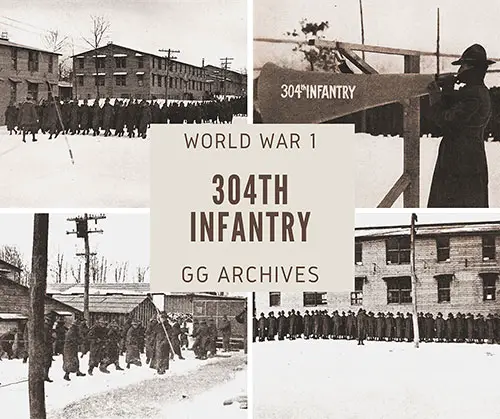
From Connecticut comes the 304th Infantry, under Colonel J. S. Herron; a large number of its men were formerly employed by the industrial plants of Bridgeport, Hartford, New Britain and Waterbury.
MOVING A BUILDING
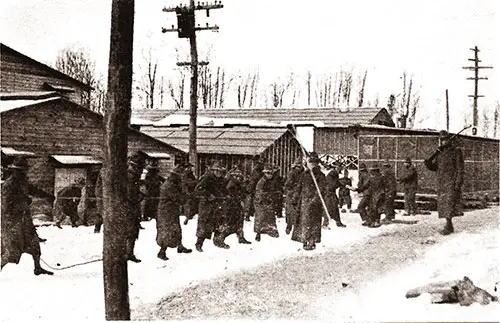
Men from the 304th Infantry Move a Building at Camp Devens. GGA Image ID # 13a3292e95
These men from the 304th Infantry realize that a soldier is expected to do every kind of work on the calendar. A building which was formerly used as sleeping quarters for the civilian workmen was needed near the regimental headquarters for a motor-cycle garage.
Accordingly, a detail was called to transfer it, and now the moving is in full progress. They have about three blocks farther to go, but judging from the happy expressions on their faces, the distance does not seem to be of much concern.
The Bugler
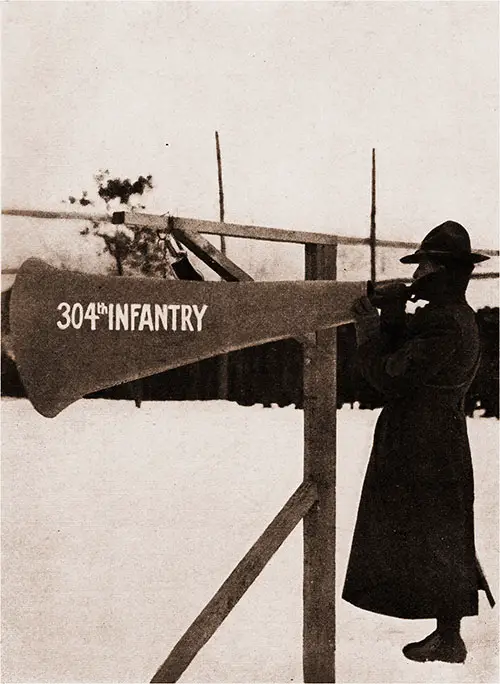
The Bugler, 304th Infantry performing Mess Call at Camp Devens (With the Aid of a Megaphone). GGA Image ID # 13aa35784a
One of the most ardent ambitions of the small boy, in these times of wars and rumors of wars, is undoubtedly someday to be an army bugler. This enthusiasm and envy is by no means limited to the youth; it is shared by people of mature years, and even by the soldiers themselves.
There is something picturesque about the bugler, and something that suggests romance in his notes. Before anyone is astir, with the exception of the cooks, the bugler comes from his barracks in the dim morning light, and shrills the "first call," which precedes reveille.
It then seems as if someone turned on an electric switch which rouses inanimate beings to activity, and changes darkness into light. The lights in the barracks flash; there comes from all sides the sound of closing windows, the dropping of shoes, and inharmonious yawns. The bugler has awakened the camp.
Throughout the day he announces mess, sick-call, drill-call, and numerous others until taps blows, when the same magic notes turn out the lights and silence the songs and voices of thirty thousand men.
Owing to the wide area over which the buildings are distributed, the men blow their instruments into a megaphone. In this picture, the bugler of the 304th Infantry is announcing to his comrades, who have just returned from drill, that mess is waiting for them.
THE 304TH INFANTRY
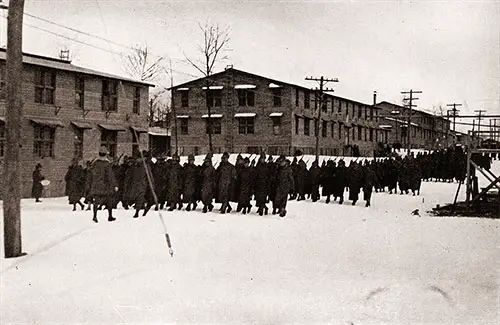
Columns of Platoons from the 304th Infantry. GGA Image ID # 13a6e8abfb
From Connecticut comes the 304th Infantry, under Colonel J. S. Herron; a large number of its men were formerly employed by the industrial plants of Bridgeport, Hartford, New Britain and Waterbury.
Some of the men were unable to speak English, and others had never learned to write. I saw the roll call of Company G, commanded by Captain Charles D. Case; parts of it resembled a list of Russian fortresses and similarly unpronounceable names.
The sergeant who calls the roll did not find it easy to clearly enunciate patronyms which begin with “Kryz-,” or “Crmn-”. These examples are by no means exaggerated ; similar arrays of consonants are common things on the company rosters.
Such conditions are not confined to this regiment, but are found in every organization at Ayer; they are more than ordinarily prevalent in the 304th because of the large number of men from the industrial cities which contributed their quota to that unit.
The authorities have made every effort to bring to these men of foreign birth the same knowledge of the English language enjoyed by their native-born comrades. Schools teaching written and spoken English were formed, and those men who had not been educated were required to attend.
The results have been remarkable, as the pupils have shown, from the first, a keen desire to learn. And although, on account of their lack of knowledge of English, they were at first somewhat slow in mastering the elements of drill, they soon acquired a proficiency which rivalled that of their American-born fellow soldiers.
It is hard to realize that many members of this column of platoons, which is now marching like a veteran body, were working at machines three months before and had not the slightest idea of military regulations.
Then some of them could not understand spoken English, and their only idea of discipline was that of the factory. Now they are living under better conditions than some of them enjoyed in the factory towns from which they came, keeping regular hours, taking continuous exercise and eating good, wholesome food. Is it any wonder that they make such a good showing?
THE REVIEW OF 304TH INFANTRY
In a military cantonment, reviews of regimental units are held frequently, both for the delectation of the higher officers and other dignitaries, and also for practice in mass drilling and formations. These pictures present the general aspects of a regimental review.
In the course of the morning, the order comes to the company commanders to be ready for a review of the regiment at 11.30. Drill is ordinarily suspended, and the men are given an opportunity to clean their uniforms, polish their shoes, and prepare their rifles and equipment for the usually attendant inspection by the person or persons in honor of whom the formality is held.
At 11.15, the company commanders order their units to form in company line. He then conducts an informal inspection of the men.
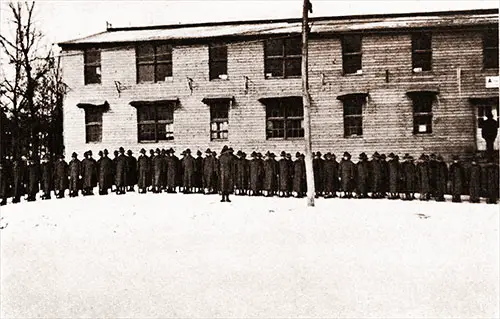
Formation of Company A, 304th Infantry. GGA Image ID # 13a731529f
“A” company has just formed, and the captain is explaining the procedure that is to follow. At the same time, the other companies are likewise forming and receiving the same instructions. The captain then marches the company to the place where the battalion is to assemble. He reports to the major, who takes charge of the battalion, and marches it to the designated place on the parade ground.
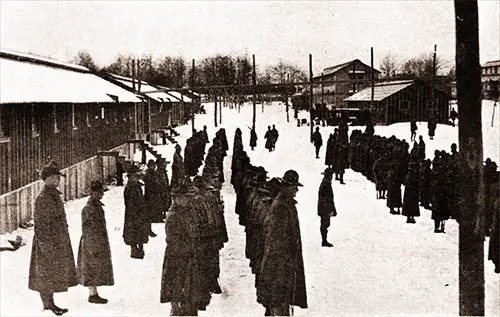
Standing at Attention - First Battalion, 304th Infantry. The first battalion has taken its place, and the line in the rear is standing at attention. GGA Image ID # 13a741c39c
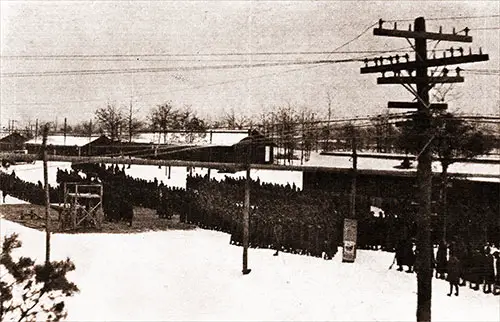
304th Infantry Regiment Standing in Formation at Attention. GGA Image ID # 13a75d1a1a
The entire regiment is now in position before the reviewing stand. An officer with a megaphone is explaining certain details which must be learned before the next formation.
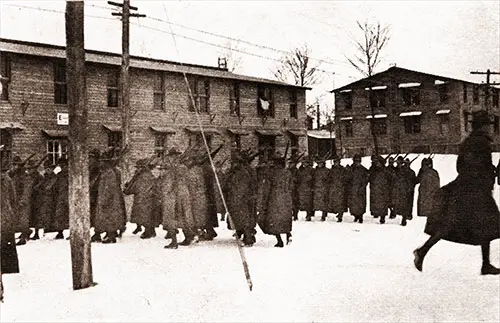
Platoon Right by Squad - 304th Infantry Changes Formation. GGA Image ID # 13a772f50c
The formality being over, the battalions are returning to their barracks in column of platoons, that is to say, several squads abreast. The order comes “Platoon right by squads.” The platoon on the left is changing its formation and instead of marching in platoon line, like the second unit in the picture, it is forming a column of squads, — one squad behind the other, the usual marching formation. In this formation, the captains take their men to their barracks.
Marching
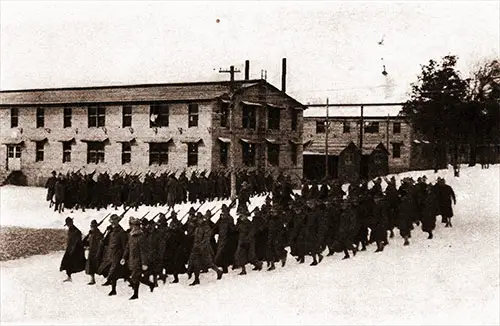
Men From the First Battalion of the 304th Infantry About to March to the Drill Field for Practice in Battalion Formations and Movements. GGA Image ID # 13a8c2c7dd
THE RIFLE RANGE
After the camp was completed, the authorities scanned the neighborhood for a suitable rifle range for the draft men and eventually selected an immense field about two miles distant from the camp.
A number of short ranges were established, some of 100 yards, some of 200, and others equipped with apparatus designed for practice with low caliber rifles.
Every man in camp will take his turn at the ranges. The soldiers go for practice in company or battalion units, and their efforts are carefully supervised by officers and expert riflemen.
For those who are unacquainted with the equipment of a rifle range, a short description might be welcome. The men fire from three positions: prone (i. e. lying on the stomach), kneeling, and from a standing position.
The targets have a black bulls-eye in the center, with larger rings encircling it. A bulls-eye counts five points, and the corresponding rings, four, three, and two; a hit on any part of the target counts two.
After the man has shot, the markers, who are in a trench beneath the targets, pull them down and examine them; then they raise them again by a system of pulleys, and designate with a disk, which is on a long pole, the position of the hit.
A scorer, standing behind the firing line, keeps a careful record of the score. Ten shots are fired, and the percentage is figured on the basis of a possible total of fifty.
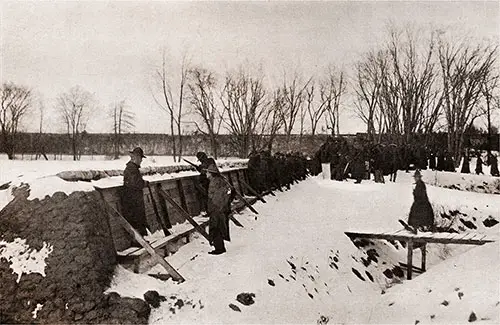
Men from the 304th Infantry at the Firing Range at Camp Devens. GGA Image ID # 13a99ae2af
The men in the picture, belonging to the 304th Infantry, are firing from a trench which is an exact copy of a firing trench on the western front. When standing on the floor of the trench, the soldiers are not in range of the enemy’s rifle fire; the firing step enables them to shoot over the top of the parapet.
The scores of the men have been most gratifying; at the 100-yard range, some organizations of the 304th have had an average of forty out of a possible fifty points.
